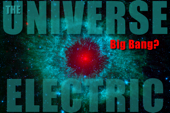Hexagonal Craters on Mercury
01/27/2008
In my recent essay The Craters are Electric, I enumerated many examples of craters on celestial bodies that cannot be explained within the traditional geologic toolkit. One strikingly anomalous crater-type is the hexagonal crater, a feature observed on many planets and moons throughout the solar system. Obviously, the impact hypothesis never envisioned hexagonal cratering patterns, nor have impact experiments ever suggested any kinetic force that might generate such a form.
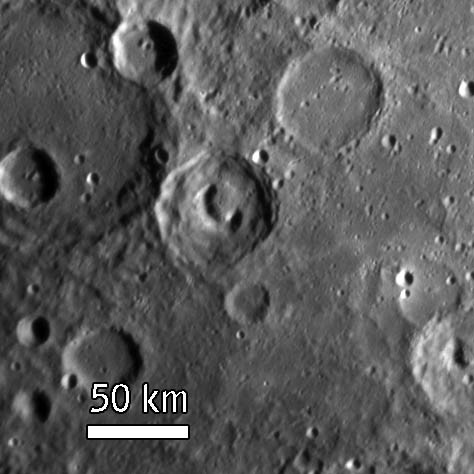
Our planetary neighbors provide an endless "laboratory in space" in which to test the electric cratering hypothesis. Presently, the planet Mercury is under close scrutiny, with scientists working on NASA's MESSENGER mission analyzing more than 1200 images returned from the recent flyby. In the image above, we see a central crater that NASA describes as "intriguing." In its center is a telephone shape that NASA calls a "collapse feature," which according to standard thinking is caused by volcanic activity. The NASA website makes no mention, however, of the crater's hexagonal form (and the hexagon-shape of other craters in the image as well.)
Although NASA routinely describes the telephone shape as a "collapse feature," it needs to be said that no evidence exists to support this explanation. NASA suggests that the shape could "reflect past volcanic activity at and just below the surface" of the crater. But again, for this interpretation there is literally no evidence. And if NASA scientists are forced to such implausible explanations, it is only because of their complete disinterest in the electrical hypothesis. It raises the specter of the earlier debate between geologists and astronomers over a volcanic or impact origin of craters on the Moon. William Morris Davis once pointed out with wry humor that "astronomers tended to explain the craters of the moon by volcanic action, a geologic process, while geologists tended to explain them by meteoritic action, an astronomic process-each scientist evidently feeling free to take liberties with a field other than his own." W M Davis, 1922, Origin of Coon Butte. It was finally decided by "a show of hands."
Upon seeing this image, some in the Thunderbolts group were instantly reminded of the polar vortex configurations seen on both Venus and Saturn. According to the leading proponent of the Electric Universe, Wallace Thornhill, these spiral vortexes are due to concentrated electric current flows along the magnetic field direction to the poles. They show precisely the configuration and motion of Birkeland current filaments in plasma discharge experiments. It was Thornhill's understanding of the electrical nature of the vortexes that led him to explicitly predict that BOTH of Saturn's poles would be hot -- a WILDLY unconventional prediction that was recently CONFIRMED.
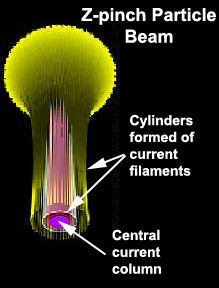
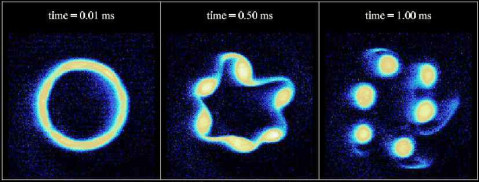
Above are images of vortex formations formed in cylindrical particle beams. Over a century ago, the Norwegian physicist Kristian Birkeland produced vortex structure and vortex interactions in charged particle beams through low vacuum in his "terrella" cathode experiments. The circular pattern in the discharge will switch to a polygon as parallel Birkeland current filaments in the cylinder are drawn together by long-range attractive electromagnetic forces and short-range repulsive forces causing them to rotate in pairs and form vortices. At the center of the hexagonal crater is the pattern formed by the twin filaments of the central Birkeland column, which has created the strange cratering pattern similar to the complex central vortex seen at the Venusian pole.
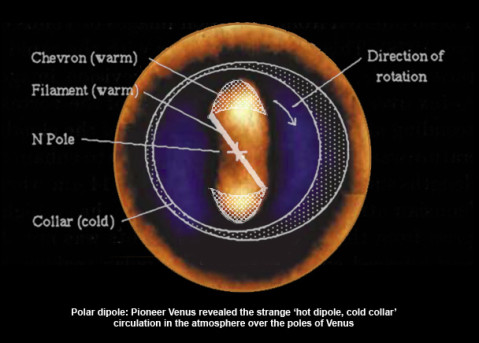
As Thornhill noted in his recent piece, "2008-Year of the Electric Universe," Jupiter has also been found to have a hexagonal cloud collar at its north pole, and the planet's Great Red Spot "occasionally shows clear hexagonal morphology, too." Also, some galaxies exhibit hexagonal structure within a circular arc, and show the characteristics of "diocotron instabilities" in their spiral arms. In other words, in an Electric Universe, we should expect to see the polygonal structures observed in planetary atmospheres (particularly the polar regions), and similar forms aligned to the axes and along the arms of some galaxies.
From the Electric Universe perspective, hexagonal craters like the ones seen above are the telltale signs of electrical scarring in an earlier epoch of planetary instability,and vastly more intense electrical activity. Whereas the impact hypothesis has failed completely either to predict or to explain the dominant crater features on planets and moons, experimental (electrical) plasma science provides a hypothesis whose success continues to grow with new observations.
Permalink to this article.
Public comment may be made on this article on the
Thunderbolts Forum/Thunderblogs (free membership required).
For a highly-acclaimed 60-minute video introduction to the Electric Universe, see
Thunderbolts of the Gods on Google Video.
|

Michael Goodspeed is a freelance journalist who lives in Beaverton, Oregon
My Archives
Chronological Archives
Archives by Author
Archives by Subject
Thunderblogs home
|






